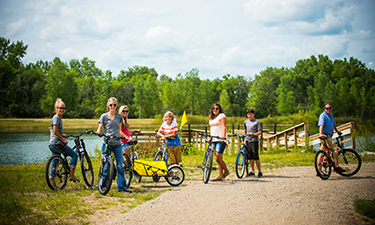 What happens to a landfill once the dumping has ceased and the garbage piles are capped? Most people would not think a landfill site could become a prime location for recreation activities. A few towns have converted landfills into parks, and fewer still have created complex ecosystems with educational outreach and recreational program opportunities. In Brookings, South Dakota, the Parks, Recreation and Forestry Department (BPRD) created its first landfill site park in the late ‘70s; however, it is the most recently closed landfill site on the south edge of town that is creating great excitement in the community. The Dakota Nature Park site was purchased by the city in the 1950s for a landfill, and after decades of use, the landfill was capped in 1994. Upon its closing, the management of the site was turned over to BPRD.
What happens to a landfill once the dumping has ceased and the garbage piles are capped? Most people would not think a landfill site could become a prime location for recreation activities. A few towns have converted landfills into parks, and fewer still have created complex ecosystems with educational outreach and recreational program opportunities. In Brookings, South Dakota, the Parks, Recreation and Forestry Department (BPRD) created its first landfill site park in the late ‘70s; however, it is the most recently closed landfill site on the south edge of town that is creating great excitement in the community. The Dakota Nature Park site was purchased by the city in the 1950s for a landfill, and after decades of use, the landfill was capped in 1994. Upon its closing, the management of the site was turned over to BPRD.
During the years immediately after the landfill was decommissioned, the site was used for fishing, dog training and other self-guided recreational activities by those who knew about its clandestine existence. In the ‘60s, topsoil had been salvaged from the landfill site, creating a network for four large ponds that are constantly refreshed by the groundwater aquifer. Four years ago, in partnership with the South Dakota Department of Game, Fish and Parks, BPRD began stocking the ponds twice a year with rainbow trout, crappie and largemouth bass, supporting a diverse fishery that attracts anglers of all ages. BPRD Director Pete Colson states, “The close proximity of the park to the city and recreation trails makes family fishing trips with smaller children an easy and safe outdoor experience. We are constantly trying to develop new ways to promote healthy activities in the outdoors and connect people, particularly children, with nature.”
An ad-hoc citizens’ committee and group of landscape architects framed a master plan for the development of the nature park in 2010, and within months of the plan’s completion, significant private donations and state grants allowed the project to move from a 10-year development schedule to a two-year construction and completion plan. The Brookings citizenry participated widely in the formulation of the vision and embraced the wellness and economic advantages that an urban nature retreat could bring to the city. A 5,300-square-foot educational center, containing a classroom, large atrium and a four-season porch, serves as the welcome center for the park. The center resembles a mountain lodge with its Douglas fir, timber-frame construction and cedar-shake shingles; the sustainable design utilizes geothermal heating and cooling to maintain the interior environment, and large windows throughout the facility allow for abundant natural lighting.
Designed specifically to encourage people to be active, park patrons must park in one of the two parking lots on opposite ends of the park and explore the interior landscapes by foot or bicycle; the park, center and fishing docks are all ADA-accessible. Summertime offers fishing, hiking, bird-watching, geocaching, kayaking and biking opportunities. In the near future, a mountain biking flow track and skills park will be featured in the north end of the park. During the winter, the park is populated by ice fisherman, snowshoe-clad hikers and cross-country skiers navigating groomed trails. Future development plans for the park include prairie restoration projects, wildlife food plots and extensive nature-based programming including astronomy, aquatics and ornithology classes.
Communities often ponder what to do with a landfill after it has served its purpose. With all of the knowledge, technology and equipment available today, these properties can be returned to sustainable spaces that draw people out of their homes and cars and invite them to play and explore in the outdoors.
Chase Ellis, CPRP, is the Recreation Superintendent for the City of Brookings, South Dakota.

